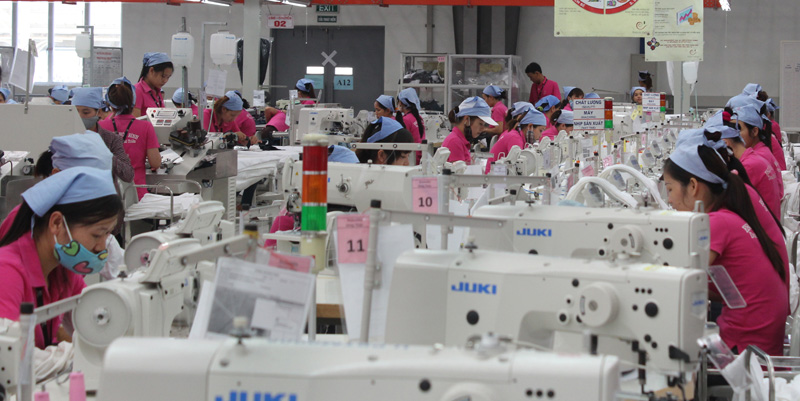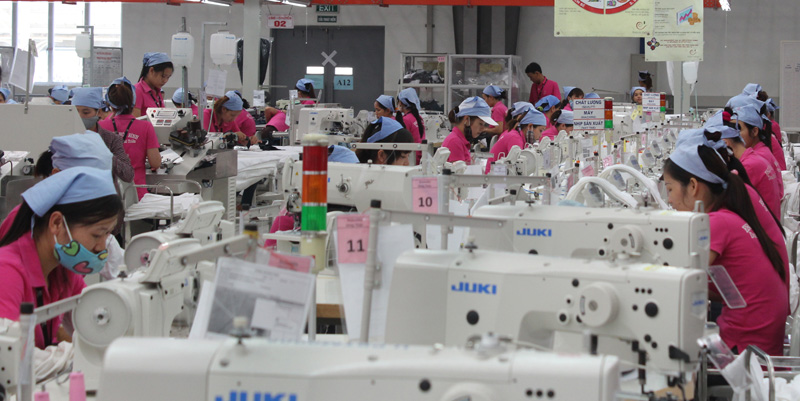
(HBO) – The complicated developments of COVID-19 have seriously affected all social aspects, especially economic development. Growth decline was recorded in many fields. In the first quarter of 2020, the gross regional domestic product (GRDP) was estimated at 6.62 percent. The figure is projected at 4.57-5.86 percent in the second quarter due to the impact of the pandemic on business and production activities.
 Garment-textile export firms at Luong Son industrial park
meet an array of difficulties to maintain business and production due to
COVID-19. Photo: Esquel Garment Manufacturing (Vietnam) Co., Ltd.
Garment-textile export firms at Luong Son industrial park
meet an array of difficulties to maintain business and production due to
COVID-19. Photo: Esquel Garment Manufacturing (Vietnam) Co., Ltd.
As of April 15, 136 local businesses and one
cooperative dissolved, while 1,392 household business establishments registered
for halting production. The number of firms having to withdraw from the market
or suspend operation is expected to surge in the coming time, especially
small-and medium-sized ones.
Along with businesses, cooperatives and business
households, workers, especially low-income earners, have been seriously
affected. As many as 275 employees had their labour contracts terminated, while
over 1,330 others had to halt working during COVID-19.
Promoting the economy after the pandemic is an
extremely important task to achieve socio-economic development targets in 2020.
To achieve the goal of collecting 5 trillion VND
(213.3 million USD) to the State budget this year, the provincial People’s
Committee has directed reviewing all revenue resources, especially from hydropower
and land use fees.
Investors and management boards of projects were
tasked to focus on preparing investment and land clearance. The province will
strictly handle those with slow disbursement of public investment.
The provincial People’s Committee requested all
sectors to continue paying great attention to curbing the disease as well as
supporting businesses to remove difficulties./.
According to data from the Hoa Binh Provincial Party Committee, the industrial production index for the first six months of 2025 is estimated to have increased by 20% compared to the same period last year. This marks the highest year-on-year growth rate for this period since 2020.
In the first six months of 2025, Hoa Binh province’s export turnover was estimated at 1.145 billion USD, marking an 18.11% increase compared to the same period in 2024. Import turnover was estimated at $ 804 million, a 17.15% increase, which helped the province maintain a positive trade balance.
The lives of the ethnic minority farmers in Tan Lac district have gradually improved thanks to the new directions in agricultural production. This is a testament to the collective strength fostered through the professional associations and groups implemented by various levels of the district’s Farmers’ Union.
With the motto the "product quality comes first,” after nearly one year of establishment and operation, Muong village’s Clean Food Agricultural and Commercial Cooperative, located in Cau Hamlet, Hung Son Commune (Kim Boi district), has launched reputable, high-quality agricultural products to the market that are well-received by consumers. The products such as Muong village’s pork sausage, salt-cured chicken, and salt-cured pork hocks have gradually carved out a place in the market and they are on the path to obtaining the OCOP certification.
In the past, the phrase "bumper harvest, rock-bottom prices" was a familiar refrain for Vietnamese farmers engaged in fragmented, small-scale agriculture. But today, a new spirit is emerging across rural areas of Hoa Binh province - one of collaboration, organisation, and collective economic models that provide a stable foundation for production.
Maintaining growing area codes and packing facility codes in accordance with regulations is a mandatory requirement for agricultural products to be eligible for export. Recently, the Department of Agriculture and Environment of Hoa Binh province has intensified technical supervision of designated farming areas and packing facilities to safeguard the "green passport" that enables its products to access international markets.



 Garment-textile export firms at Luong Son industrial park
meet an array of difficulties to maintain business and production due to
COVID-19. Photo: Esquel Garment Manufacturing (Vietnam) Co., Ltd.
Garment-textile export firms at Luong Son industrial park
meet an array of difficulties to maintain business and production due to
COVID-19. Photo: Esquel Garment Manufacturing (Vietnam) Co., Ltd.